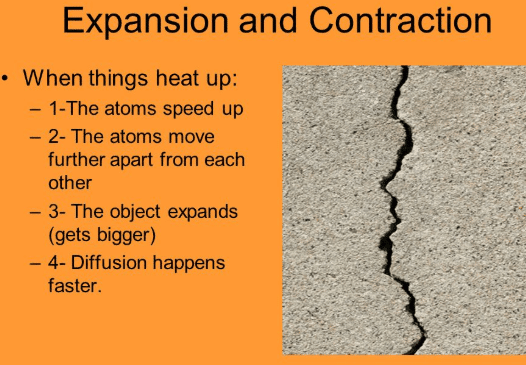Expansion and Contraction


When there is a sudden change in temperature (increase) most of the elements expand. When said temperature decreases, the elements contract.
However, it is important to make a fundamental clarification: when solids dilate due to heat, it does not mean that they increase in volume. What happens is that the distance between molecule and molecule increases causing the element to have an expansion. This expansion (or dilation ) exerts a considerable force.
This condition of solids is important to take into account, especially in bridge constructions, since it has been proven that a metal bridge that measures 50 meters and that goes from 0º C to 15º C in a short time can expand up to 12 centimeters.
However, not all solids expand in the same way and under the same temperature. For example, aluminum expands 2 times more than metal iron.
What happens inside the solid?
As temperature increases, what happens is that the internal energy of the particles increases, and the degree of agitation of the particles increases.
In other words, what happens is that each particle begins to ” vibrate” and separates from the particle next to it, in this way the expansion of the element occurs.
When the heat descends, the particles decrease the internal energy, and little by little they get closer until they find themselves next to each other.
Examples of heat expansion and contraction
- When you put a bowl in the refrigerator and remove it. In order to remove the cold from the rim of the container, the airtight container itself must be immersed in hot water, thus expanding the plastic allowing the content inside to be extracted.
- Water. When heated (boiled) the molecules expand, when they cool they contract, and when they freeze, the water molecules compact.
- Iron. This metal is found in nature in a solid-state, that is, its molecules are closer to each other. However, due to the action of heat, this metal expands and the iron becomes molten iron. The same occurs with other metals such as aluminum, mercury, lead, etc.
- Chewing gum. When the chewing gum is at a high temperature, it melts. This is seen during a hot day. Then, if we put this chewing gum in the refrigerator, it shrinks and hardens.
- The muscles of the body one day with very low atmospheric temperatures. For this reason, some people have muscle aches after an aerobic workout or on very hot and then very cold days. Who regulates this is the liquid (water) of our body. But the pain intensifies if the body is dehydrated.
- Carbonated water in the freezer.
- Timber. On a very hot day, it expands. Then, when the temperature drops, it begins to generate noises because it contracts again.
- Rails of the train tracks. These are built with a certain distance being slightly separated. Then tar is placed in this space to allow the metal to expand on very hot days and then, as the temperature drops, it contracts again.
- Glass. If we put a regular glass tumbler and add boiling water, the inner part of the glass expands while the outer part is cold. This causes the glass to break.
- The thermometer. This is made up of liquid mercury. Since particles are relatively distant from each other in liquid elements, mercury, when exposed to heat (for example, body fever), mercury rises through the thermometer since it has become more liquid.
Related Topics:
Related Post
Recent Posts
Difference between Gastritis and ulcer
Gastritis and ulcers are irritations, which must be treated urgently in order not to develop…
Saudi Arabia launches new residency plans to draw foreign talent
On Thursday, Saudi Arabia unveiled fresh residency programs geared towards drawing in skilled professionals and…
Study in UAE: Your Complete Guide to Enrolling Abroad
Studying abroad can be a life-changing experience, opening doors to new cultures, perspectives, and opportunities.…
Difference between Osmosis and dialysis
The difference between osmosis and dialysis is that Osmosis is a physical phenomenon by…
Difference between Vitamins and proteins
The Difference between Vitamins and Proteins is given here. Vitamins and proteins are essential…
Difference between Windows and Linux
The Difference between Windows and Linux is given here. Windows and Linux are operating systems…